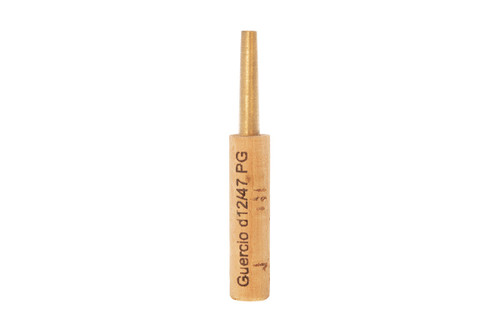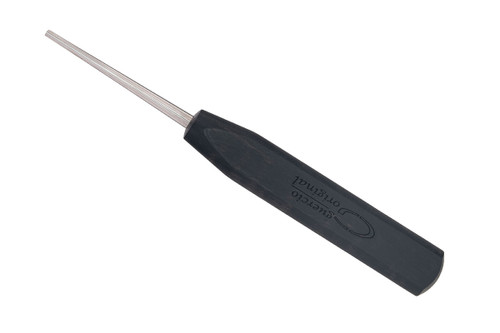Guercio Brass Oboe Staples
Guercio, a German staple manufacturing company for over 35 years, produces staples following the Klopfer model. They have perfected a rolling process with seamless tubes made of high-quality materials which guarantee a unique sound that musicians all over the world appreciate. Available in a variety of models, there is something for everyone. In addition to their regular brass, Guercio offers a unique brass alloy that contains 35% more copper, creating a more gentle sound. Solid silver and Gold and Palladium plating are also available. Palladium is the least dense of the platinum group metals, all of which yield a more direct, robust sound that can grow heavy. As a less dense metal, Palladium will be less harsh. Gold plating offers a vibrancy and warm tonal sweetness while the solid silver gives a little more power but in a gentle way, close to the results of Guercio's special brass alloy. Precious Metal Oboe Staples are listed separately.
The various Guercio models that start with D are all variations on the old, well-liked Klopfer staples which Gottfried Möckel sorted into sub-sections. A couple of others have also been influenced by current great European oboists such as Albrecht Mayer of the Berlin Philharmonic and Carlo Romano of l’Orchestra Sinfonica Nazionale della RAI in Tourin, Italy.
Guercio uses a taper style that produces more volume than most other staple manufacturers with a similar top-to-bottom ratio. Their staples have two places where the angle changes and they also "pinch" the top on some staples (D10, D26, G1). To increase the volume, they add a shoulder in the middle to the R12.
- Country – made in Germany
- Manufacturing Process – a rolling process with seamless tubes following the Klopfer model
- Cork – natural cork, approx. 29mm long
- Wall Thickness – medium-thick walls that get thinner at the base (.23-26mm decreasing to .19-.20mm)
- Metal Type – available in brass, nickel-silver, special brass alloy, solid silver, gold-plate, palladium-plate
- Tip Area – varies by staple model
- Base Diameter – varies by staple model
- Tip Shape – varies by staple model
- Mandrel – mandrel available for each model
- 8 Models
AM Model
- Tip Area – large, but less than the Guercio D26
- Base Area – 18.63mm2 (4.87mm diameter), large, almost the same as the D26
- Tip Shape – rounder, yet not as round as the D26
- Volume – large, but not quite as much as the D26
- Taper – average, unlike the D26 which is quite straight
This staple is based on the Klopfer model D26. Albrecht Mayer influenced this to match with his oboe, manufactured by German instrument maker Gebrüder Mönnig and named after him. The main difference between it and the Klopfer D26 is the area at the tip. The AM is a bit smaller than the D26, though both are large compared to most other staples.
D10
- Tip Area – smallest of all, quite a bit smaller than the Lorée DM
- Base Area – 16.48mm2 (4.58mm diameter), small, similar to the Lorée DM
- Tip Shape – almost round
- Volume – small, but a little bigger than Lorée DM
- Taper – very angled, unlike the Lorée DM which is on the straighter side
The smallest Klopfer model, it is best paired with German-style oboes such as Ludwig Frank, Mönnig, Springer, and Josef. It has a pinched almost round tip which makes the tip very small but still has good volume in the rest of the staple to produce a good sound. It is considered a "tighter" staple producing a darker tone, easier low notes, and a flatter region above A5. The shape of this staple will also tend to make reeds more open.
D11
- Tip Area – small, just slightly larger than Guercio D10
- Base Area – 16.72mm2 (4.61mm diameter), small, just slightly larger than Guercio D10
- Tip Shape – average oval
- Volume – small, just slightly larger than Guercio D10
- Taper – very angled, about the same as the D10
This model has a more oval small tip (bigger area compared to the D10, though) and is not pinched so there is less resistance. As with all small tips, the cane will need to be tied longer than on a larger tipped staple. This staple will help close down a reed.
D12
- Tip Area – smaller average, much bigger than the D11
- Base Area – 17.01mm2 (4.65mm diameter), small, very similar to the D11
- Tip Shape – average oval, same as the D11
- Volume – average, much bigger than the D11
- Taper – straighter average, about the same as the Lorée DM
The D12 is the more standard staple that is similar to the Chiarugi 2 and Lorée. The differences are that the walls are thicker giving a little darker, fuller tone and the base is a little bit smaller. They accommodate a higher pitch more easily than bigger based staples by compensating for the octave weaknesses of short staples. This staple matches well with the French-style oboes such as Lorée Royal, Marigaux, Buffet, Rigoutat, and Howarth. German players have especially liked these staples because they offer a large dynamic range with freer response, though less refinement or sweetness than the D10 and D11.
R12
- Tip Area – smaller average, about the same as the D12
- Base Area – 17.01mm2 (4.65mm diameter), small, same as the D12
- Tip Shape – average oval, same as the D12
- Volume – large, much bigger than the D12
- Taper – straighter average, about the same as the D12
The R12 is a staple made in collaboration with the Italian oboist, Carlo Romano. It has the same basic measurements as the D12 but larger internal volume created by a shoulder section in the middle of the taper, keeping the sound more stable.
D26
- Tip Area – large, more than the AM
- Base Area – 18.76mm2 (4.89mm diameter), large, almost the same as the AM
- Tip Shape – almost round, the roundest staple we sell
- Volume – large, more than the AM
- Taper – straight, unlike the AM which is quite average
The D26 is the largest Klopfer model. It has a significantly larger bottom diameter and the tip is large and more round than the other Klopfer models. In addition, it has a very large internal volume due to the pinched tip. This gives it slightly higher pressure at the beginning but a nice, clear sound going into the oboe. The large tip will require a wider-based shape and will cause the base of the reed to be more open and to close down the tip. Overall, this staple will tend to play slightly sharp.
G1 (Glotin Copy)
- Tip Area – large-average, close to the Lorée regular
- Base Area – 18.56mm2 (4.86mm diameter), large, same as the Lorée AK
- Tip Shape – quite round
- Volume – large
- Taper –average, similar to the Lorée regular
This is a copy of an old Glotin staple which many have come to love. This is different from a contemporary Glotin staple and from Chiarugi's Glotin copy. The Guercio Glotin copy has a small bottom diameter and a smaller, rounder tip compared to the other two. Some of the smallness in the tip measurement is compensated by the pinched tip which allows more volume inside the staple despite the tip measurement.
GC1 (Guercio 1)
- Tip Area – small, similar to Chiarugi 1, smaller than Marigaux 2
- Base Area – 15.46mm2 (4.44mm diameter), the smallest that we offer, similar to Chiarugi 1, smaller than Marigaux 2
- Tip Shape – average, same as the Lorée DM
- Volume – small-average, close to the Guercio D11, larger than the Marigaux 2
- Taper – straight, same as the Marigaux 2
This staple is a recent design by Carmelo Guercio and is made especially to suit Marigaux oboes. Though the overall size is smaller than the Marigaux staples, it has the exact same top-to-bottom ratio as the Marigaux 2 staple. Having the smallest base diameter of any staple we offer on our site, the ellipse size and shape are, however, very similar to the D11, though very slightly rounder and bigger. Even though the base is quite a bit smaller and the ellipse size is only slightly bigger, the GC1 provides significantly more volume than the D11 due to its internal shape. The Guercio 1 also has more volume than the Marigaux 2 despite the top-to-bottom ratio being the same. This is likely due to the Guercio models all having a straighter angle near the bottom which essentially gives more volume than staples without the angle change.
Make sure to look through the staple tip annotated pictures here to see actual measurements and closeups of the tip shape.
For extensive information on choosing oboe staples, read our Oboe Staples Guide, How to Select Your Oboe Staple
No one has reviewed this product! Write a Review




























